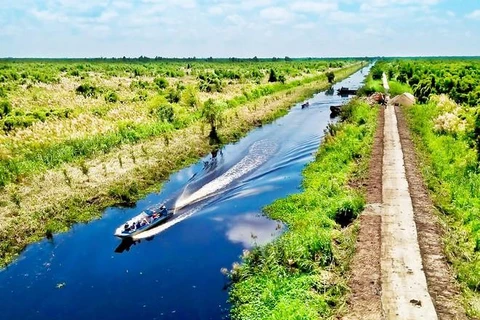Hanoi (VNA) – The Hoang Lien National Park in the northern province of Lao Cai is home to great ecological diversity and also many scenic landscapes, promising to become an eco-tourism site.
At the ASEAN Heritage Parks conference held in Thailand in December 2004, Hoang Lien was among four national parks of Vietnam recognized as ASEAN Heritage Parks. The other three are Ba Be in the northern province of Bac Kan, Chu Mom Ray in the Central Highlands province of Kon Tum and Kon Ka Kinh in the Central Highlands province of Gia Lai.
Hoang Lien National Park was established on July 12, 2002 under Decision 90/2002/QD-TTg of the Prime Minister, on the basis of the Hoang Lien nature reserve in Lao Cai’s Sa Pa district.
The park is home to the Fansipan Mount, the highest mountain in Indochina, which is part of the Hoang Lien Son range running through six communes: San Sa Ho, Lao Chai, Ta Van, Ban Ho communes of Sa Pa district, and Muong Khoa and Than Thuoc communes of Lai Chau province’s Than Uyen district.
The Hoang Lien Son range is an extension of the Ailao Shan range, to the east of the Himalaya. The area has two sub-climate zones – temperate and sub-tropical, resulting in great ecological diversity.
The park has a total natural area of 29,845 hectares and is divided into three zones: the strictly protected zone with an area of 11,800ha, the ecological restoration zone of 17,900 ha, and the administrative, tourism and service zone of 70ha. It is surrounded by a 38,724 ha buffer zone.
The park is bordered by Phong Tho district of Lai Chau province to the east, Than Uyen district of Lai Chau to the south, and Sa Pa district of Lao Cai to the north.
Due to its location in the highest mountain region in Vietnam, the terrain here is divided strongly, with steep slopes.
The climate here is mountainous temperate, with average temperature at 15.3 degrees C. In winter snow and frost may appear on areas at high altitude.
The fauna and flora in the park are very abundant and diverse, with many species now found only in Hoang Lien. Scientists have listed 2,024 flora species accounting for 25 percent of indigenous species of Vietnam, along with 66 mammal species, 61 reptile species, 553 insect species and 347 bird species. Many of them have been included in Vietnam Red Book on rare and precious flora and fauna.
At the end of 2003, scientists conducted a research project on the flora and fauna systems in Hoang Lien, which produced impressive results.
They collected more than 3,000 samples of more than 1,000 plant species, including those of rare and valuable species such as Hoang Lien chan chim (Coptis teeta Wall) , Do quyen (Rhododendron) and kim giao (Nageia fleuryi).
At the Den Thang area on an altitude of 2,000m, the scientists discovered a Po mu (Fokienia hodginsii) forest with many trees as big as 1m in diameter. The forest covers an area of around 100 hectares.
On an altitude of 2,500-2,800m, the scientists found a vast area of Do quyen, with around 20 species out of the total 27 species found so far in Vietnam.
In particular, the biggest ever found Co Linh Chi (Ganoderma applanatum) fungus weighing 5.7kg was discovered during this survey.
Regarding fauna, the scientists collected more than 50 samples of animals, such as Soc bay sao (Petaurista elegans), Soc bay trau (Petaurista petaurista), meo rung (felis bengalensis), ga loi tia (tragopan temminckii tonkinensis), to name just a few.
The recognition of Hoang Lien as an ASEAN Heritage Park provides a new direction for Lao Cai province to map out development and investment plans for the park, with the aim of turning it into a hub for scientific research, environmental education and eco-tourism.
At the end of 2018, Hoang Lien National Park was listed among the 28 best destinations in the world for 2019 by the US-based National Geographic./.
























